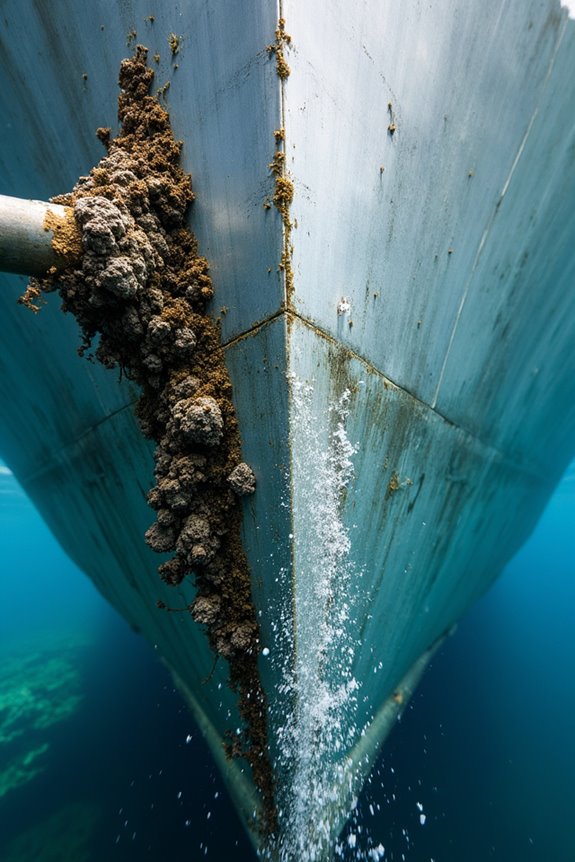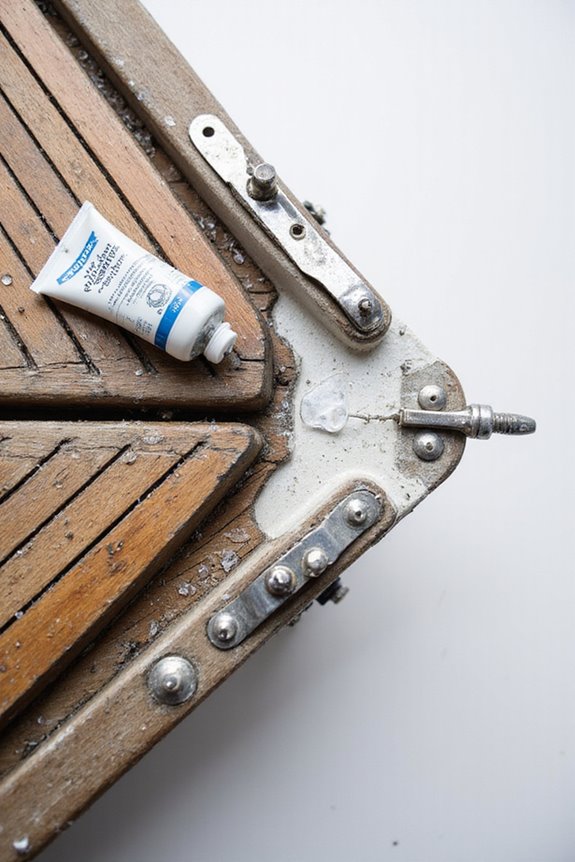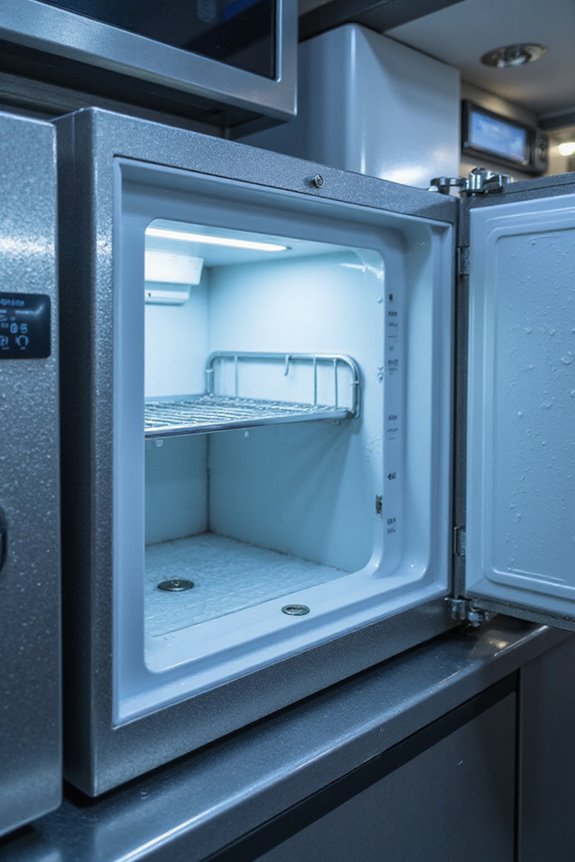We all want our vessels running smoothly, right? Underwater hull cleaning clears pesky biofouling—that slimy buildup that can boost fuel use by nearly 20% and slow us down. Not only does it save money and extend hull life, but it also protects marine ecosystems by keeping invasive species at bay. Plus, with new robotic tech and tighter regulations, cleaning’s more efficient and eco-friendly than ever. Curious how these upgrades impact your fleet’s performance and costs?
Key Takeaways
- Underwater hull cleaning prevents biofouling, maintaining vessel speed, maneuverability, and hull integrity for safer and efficient operations.
- Regular hull cleaning enhances fuel efficiency, reducing fuel consumption by up to 20% and lowering greenhouse gas emissions.
- Clean hulls prevent the spread of invasive marine species, protecting local biodiversity and marine ecosystems.
- Adhering to strict regulatory frameworks ensures environmentally responsible hull cleaning with minimal ecological impact.
- Technological advancements like robotic cleaners improve cleaning safety, speed, and enable more frequent maintenance without dry-docking.
Market Trends Driving the Demand for Hull Cleaning
While the global shipping industry continues to expand, we’ve seen a clear surge in demand for underwater hull cleaning—and it’s not just about keeping ships looking sharp. So, what’s driving this market demand? Growing maritime trade and tighter environmental rules mean ships need regular cleaning to stay efficient and compliant. We’re also excited about service innovations like robots and automated systems that boost cleaning speed and safety. These technological advancements aren’t just bells and whistles—they’re reshaping how we care for vessels worldwide. Plus, emerging markets in Asia-Pacific are jumping on board, amplifying the need for advanced cleaning services. Together, these trends create a perfect storm that keeps hull cleaning top of mind for shipowners everywhere. It’s clear: staying current means staying competitive, don’t you think?
Impact of Biofouling on Vessel Performance
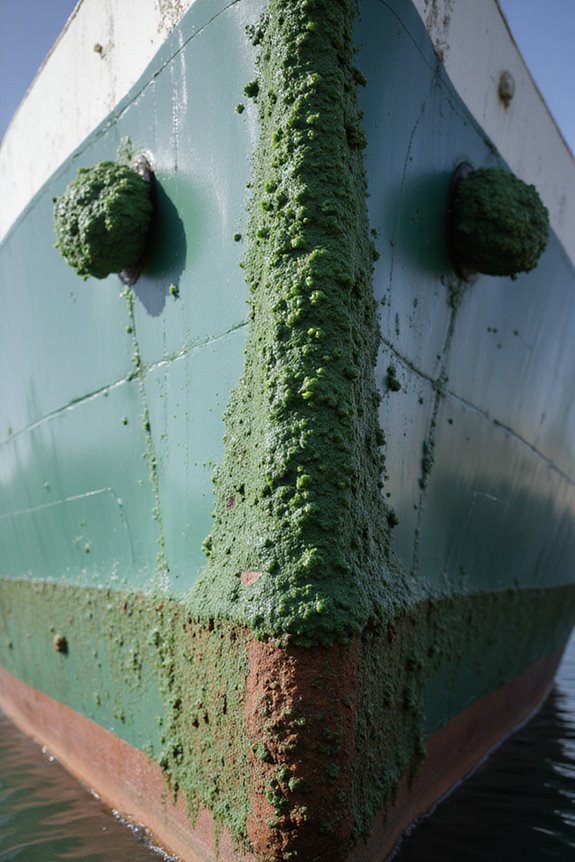
Because biofouling can sneak up on us like an unwelcome guest, it’s essential to understand how these marine hitchhikers affect vessel performance. Even a little barnacle buildup boosts hull resistance by nearly 30%, meaning our engines have to work overtime just to keep cruising speed. That extra drag? It’s not just annoying—it hampers maneuverability and puts strain on the hull, which no captain wants. But here’s the silver lining: biofouling prevention through regular hull maintenance keeps things smooth and efficient. Think of it as giving your vessel a revitalizing spa day. Staying ahead of biofouling isn’t just good for performance; it’s vital for protecting the environment and reducing operational headaches. So, let’s commit together—clean hulls keep us sailing strong!
Fuel Efficiency Gains From Regular Hull Maintenance
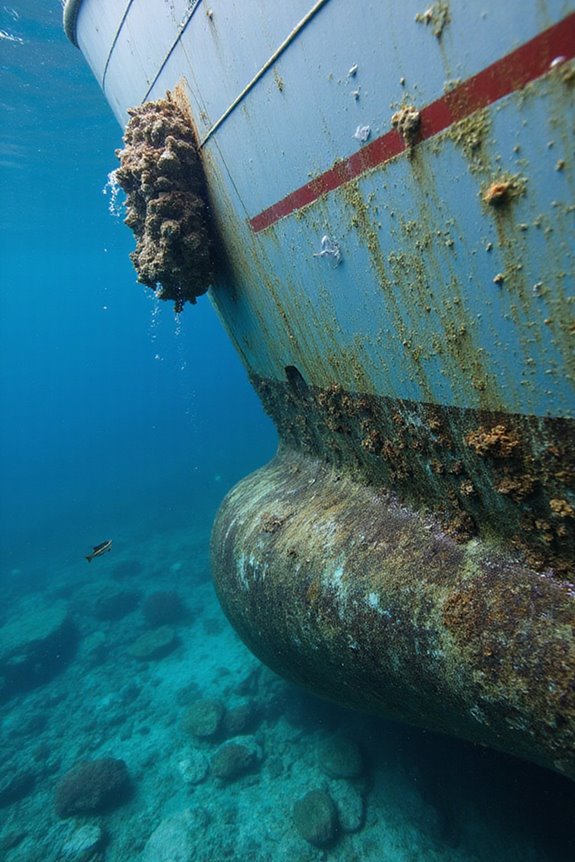
A clean hull isn’t just about looking sharp—it’s a game changer for fuel efficiency, too. When we keep up with regular hull maintenance, we dramatically cut down on the resistance caused by biofouling—the pesky buildup that makes our vessels work harder and burn more fuel. Imagine slashing fuel consumption by up to 20%, just by scheduling consistent underwater cleanings. That’s real savings, both for the environment and our wallets. Plus, hull and propeller cleaning together boost propulsion efficiency, meaning less power needed at cruising speeds. Thanks to new robotic cleaning tech, we can maintain hull smoothness more often, avoiding costly dry-dock stops. So why wouldn’t we embrace regular hull maintenance? It’s a smart move that keeps our fleet running lean and green, proving efficiency and responsibility can sail hand in hand.
Environmental Consequences of Hull Biofouling
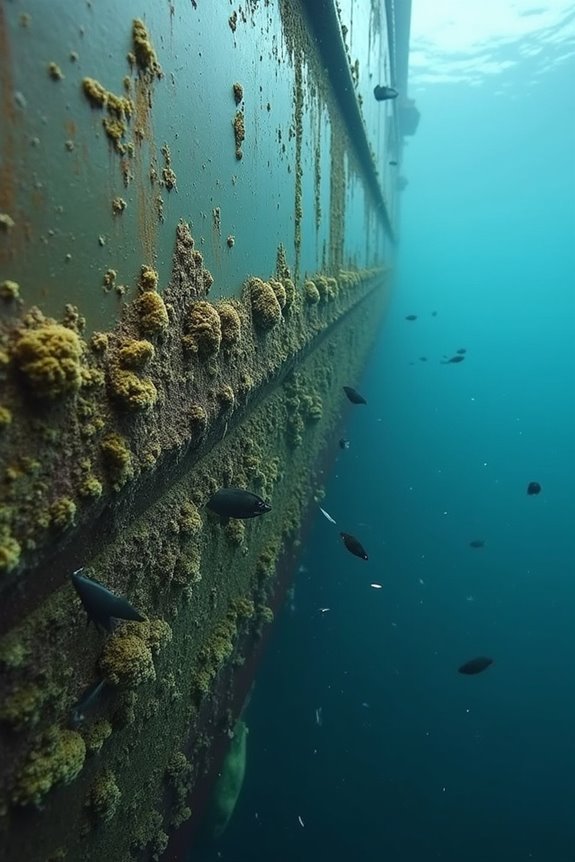
Even though we often focus on how hull biofouling affects fuel bills, its environmental consequences are just as important—and way less obvious. When we skip biofouling prevention, we’re not just adding drag to vessels; we’re unintentionally helping invasive species hitch a ride, which can mess up local ecosystems. Think about it: non-native organisms can outcompete native ones, throwing marine biodiversity off balance. Plus, the extra fuel burned because of biofouling pumps more greenhouse gases into the air, adding to climate change and air pollution problems like smog. And let’s not forget the water pollution from waste produced by those freeloading creatures. So, keeping hulls clean isn’t just about saving fuel—it’s a vital step in ecosystem protection that helps our oceans stay healthy for the long haul.
Regulatory Frameworks Governing Underwater Hull Cleaning
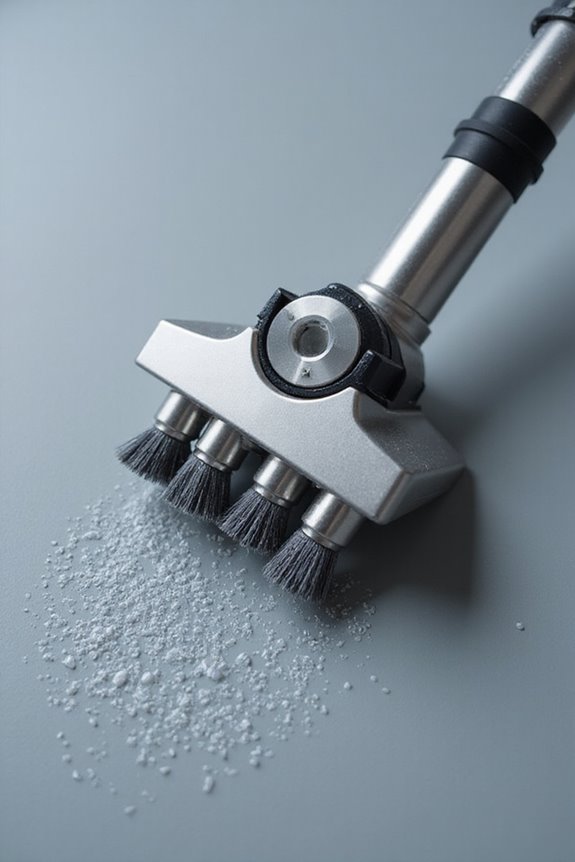
When we talk about underwater hull cleaning, it’s not just about scrubbing off slime and barnacles; there’s a whole set of rules keeping this process in check. We all need to stay on top of regulatory compliance to protect our oceans and keep operations smooth. For example, the EPA sets strict guidelines to avoid releasing toxic antifouling paint residues, while international bodies demand cleaning standards that capture at least 90% of fouling debris before discharge. Ports add their own twists, requiring permits and pre-cleaning approvals to minimize environmental impact. It’s a bit like following a recipe—you can’t skip ingredients or timing, or your whole dish (or in this case, cleaning) falls flat. So, embracing these frameworks helps us clean responsibly and keep our waters—and ships—in top shape.
Technological Advances in Hull Cleaning Methods
Though underwater hull cleaning might sound straightforward, the technology behind it has gotten pretty impressive lately, and we’re here for it. Thanks to robotic innovations, remotely operated vehicles (ROVs) now combine smart designs with advanced sensor technologies, allowing real-time monitoring of hull conditions. These sensors help spot biofouling hotspots early, so cleaning is more targeted and efficient. Plus, the integration of AI-powered systems lets these machines work continuously underwater, reducing downtime and boosting safety. It’s like having a high-tech assistant that’s always on the job, minimizing environmental impact with eco-friendly cleaning methods. So, isn’t it exciting how these advances not only protect our vessels but also keep our oceans cleaner? We think so—and keeping up with this tech keeps us in the loop for smarter, greener maintenance.
Role of Robotic and Automated Cleaning Systems
Since the shipping industry’s always looking for ways to cut costs and shrink environmental impact, robotic and automated hull cleaning systems have become real game changers. These robotic innovations offer a smarter, cleaner approach to underwater hull maintenance. Imagine a fleet of autonomous cleaners working day or night, scrubbing biofouling without harsh chemicals, all while collecting debris to keep our oceans safer. Automated maintenance means we don’t have to wait for inconvenient dry docks or rely on risky diver cleanings. Plus, these robots adapt to tough marine conditions, accessing tricky spots like propellers with ease. With up to 20% in fuel savings and millions of CO2 reductions since 2020, embracing this tech isn’t just smart—it’s our responsibility. After all, who wouldn’t want a cleaner hull and a lighter carbon footprint?
Applications Across Maritime and Offshore Industries
Although hull cleaning might not be the most glamorous topic, it plays an important role across several maritime and offshore industries you might not realize. In commercial shipping, keeping hulls clean cuts fuel use and emissions, while protecting coatings. Offshore platforms benefit from reduced biofouling that keeps structures stable and sensors clear, avoiding costly downtime. Port management relies on cleaning to control invasive species and speed up vessel turns—nobody likes waiting in port! Environmental conservation efforts highlight how proper cleaning safeguards marine biodiversity and meets stricter regulations using eco-friendly methods. And let’s not forget naval applications, where maintaining hull integrity is essential for mission readiness. So yes, this unsung task silently supports a range of operations, helping our oceans and industries run smoother than you might expect. Who knew scrubbing could be so important?
Economic Benefits of Consistent Hull Cleaning Practices
When we think about underwater hull cleaning, it’s easy to overlook just how much money consistent maintenance can save—and make—over time. Keeping hulls clean cuts fuel consumption by up to 10%, which isn’t just good news for the planet but also slashes operating costs—think savings of up to $26,000 a year per vessel! That’s real cost savings making a tangible difference. Plus, regular cleaning means less frequent drydock visits—reducing downtime and expenses, an operational win-win. We all want our fleets running smoothly and sustainably, right? It’s not just about compliance but about boosting efficiency and extending asset life, too. So, sticking to a cleaning schedule isn’t just smart—it’s essential for operational sustainability where every penny and minute count.
Sustainable Practices and Their Impact on the Industry
We’ve seen how keeping hulls clean saves money and time, but there’s a bigger story here—one that impacts the entire maritime industry and the planet we share. By embracing sustainable innovation like robotic hull cleaners and ECOHULLCLEAN’s biofouling filtration, we step up as true ecological stewards. These technologies don’t just scrub away grime; they prevent invasive species from hitching a ride and protect vulnerable marine life. Plus, they cut fuel use and reduce pollution—a win for business and the environment. Think of it as hull cleaning with a conscience. When we adopt these smart, eco-friendly practices, we’re joining a growing community pushing maritime standards forward. It’s not just maintenance—it’s making waves in sustainability and shaping a cleaner future for all of us.
Frequently Asked Questions
How Often Should Underwater Hull Cleaning Be Scheduled for Optimal Results?
We recommend setting your cleaning frequency around every 4-6 weeks during peak season, adjusting maintenance schedules based on water conditions, so together we keep your vessel efficient and protected while enjoying a supportive boating community.
What Are the Risks of Hull Cleaning to Vessel Coatings and Paint?
It is understood hull coatings can suffer paint damage from aggressive cleaning, especially if done infrequently or improperly. Together, we must balance thorough cleaning with gentle methods to protect our vessels and preserve coating integrity.
Can Underwater Hull Cleaning Be Done While a Ship Is in Port?
Like a gardener tending underwater roots, we can perform port cleaning while a ship rests in port. This smart ship maintenance lets us keep vessels healthy without interrupting their journeys, keeping us all connected in responsible care.
What Qualifications Should Hull Cleaning Service Providers Have?
We believe hull cleaning providers must meet strict certification requirements and industry standards, ensuring skilled personnel and safe methods. By choosing certified experts, we’re all part of a community committed to quality, safety, and environmental care.
How Long Does a Typical Underwater Hull Cleaning Operation Take?
When we consider typical underwater hull cleaning, cleaning techniques greatly impact time efficiency. Manual diver teams usually take 2 to 6 hours, but mechanized methods speed up the process, helping us maintain our vessels efficiently together.

